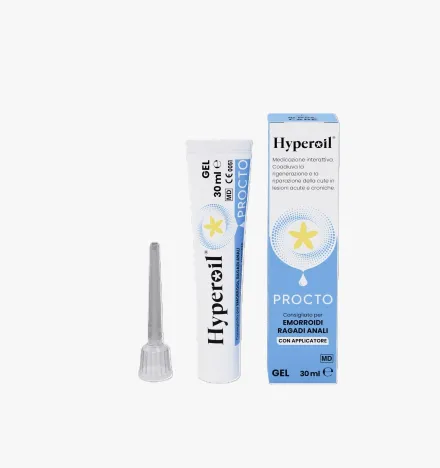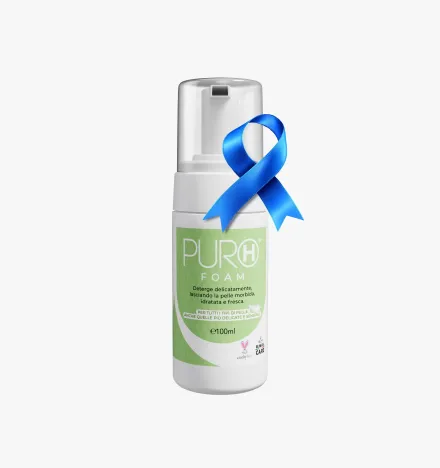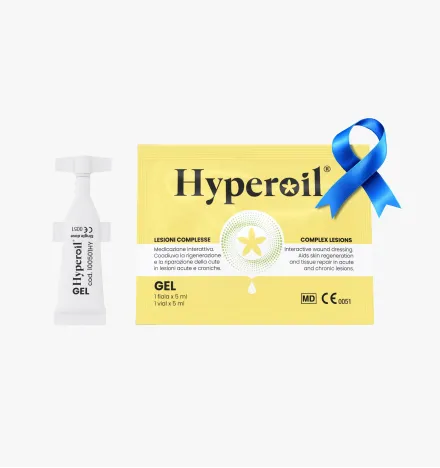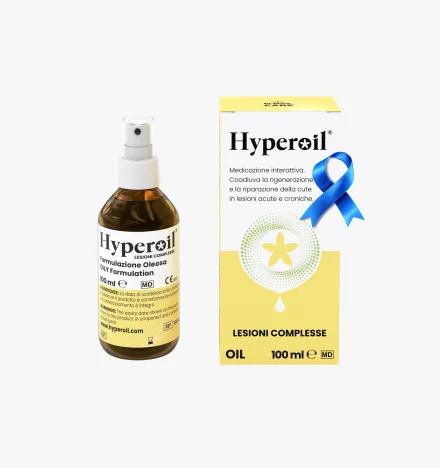Getting to Know Hemorrhoids
Hemorrhoids are important vascular structures for continence control.
However, under some circumstances, they may become inflamed or dilated, causing discomfort and pain.
Understanding the causes, symptoms, and treatment options is critical to effectively address and manage this condition.
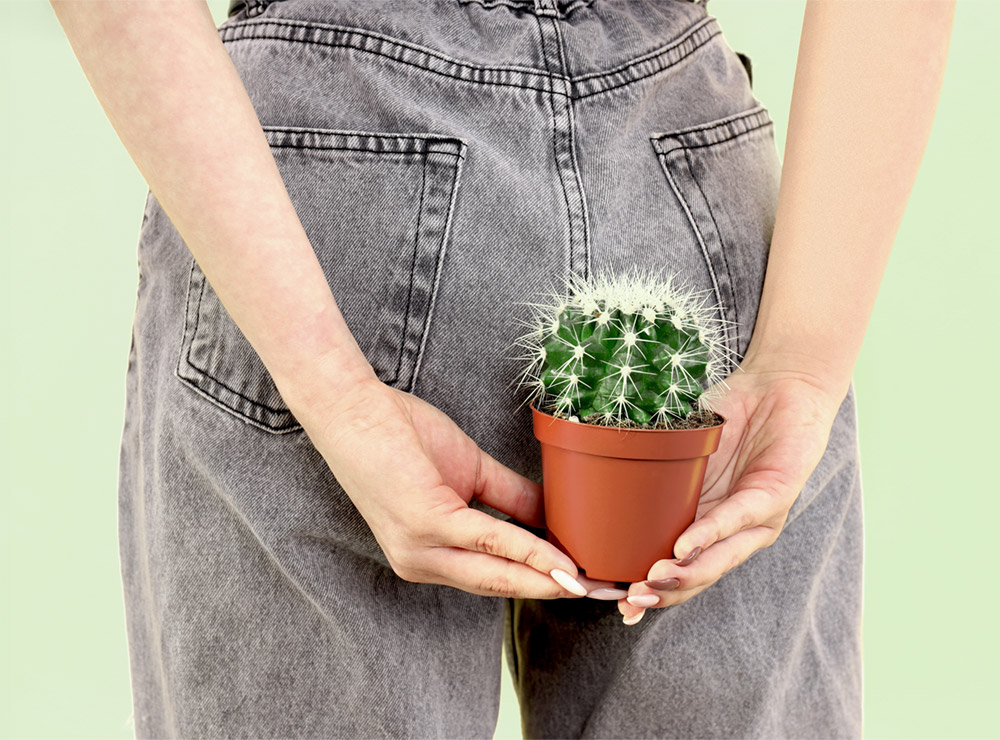
HEMORRHOIDS: UNDERSTANDING THEM, TREATING THEM, PREVENTING THEM
Hemorrhoids are a widespread condition that affects men and women of all ages. They cause discomfort, pain and often affect the quality of daily life, in some cases creating embarrassment because of the taboos associated with this disorder.
However, by recognizing the early symptoms and intervening early with medical support, it is possible to manage the condition effectively, using natural or medical treatments to limit the evolution of the condition and improve comfort in daily activities.
Hemorrhoids or hemorrhoidal disease?
We often hear of hemorrhoids to describe health problems related to the anal canal, but this term is actually misused. Hemorrhoids, technically known as the hemorrhoidal plexus, are vascular structures that occur naturally in the anal canal of all people and help regulate stool elimination.
Instead, the term hemorrhoidal disease refers to when these structures undergo changes or irritation that cause them to enlarge and possibly protrude outside the anus, leading to the painful symptoms commonly associated with hemorrhoids.
In conclusion, while hemorrhoids are a normal part of the human anatomy, hemorrhoidal disease describes the pathological condition in which these structures cause problems and symptoms.
WHAT ARE HEMORRHOIDS?
Hemorrhoids are pads of tissue, containing a rich vascular network, located at the end of the rectum. Normally, they are well anchored to the wall of the anal canal by fibrous ligaments.
These structures play an important role: they help regulate stool elimination and maintain continence, or the ability to hold stool, fluids and gas. They function by dilating and deflating to control blood flow: when they swell, they help maintain continence; when they deflate, they facilitate stool output.
Under the influence of stressors such as an unbalanced diet, hormonal changes or prolonged periods of sitting, hemorrhoids can become inflamed and swollen excessively, becoming visible and causing pain.
This condition can lead to several more or less obvious and painful symptoms. In particular, hemorrhoids may prolapse, that is, protrude outside the anal canal. Bleeding or the formation of thrombi, blood clots within the hemorrhoids, may also occur, increasing discomfort and requiring medical attention.
Types of hemorrhoids
Hemorrhoids are mainly divided into two types: internal and external. This classification is based on their position relative to the serrated line, an important anatomical landmark in the anal canal that marks the division between two different areas of mucosal lining.
Internal hemorrhoids
They are located within the anal canal, above the serrated line. During defecation they may prolapse, that is, protrude temporarily, then retract spontaneously without the need for intervention.
Under normal conditions, they are neither visible nor cause pain; however, they become a source of discomfort if prolapse persists or when complications such as fissures arise, which can make defecation particularly painful.
They are divided into four stages according to the degree of prolapse:
- 1st degree: occur with increased internal volume, visible only with specific examination, cause discomfort and bleeding.
- 2nd degree: prolapse out only with effort, such as during defecation, re-entering automatically.
- 3rd degree: prolapses independently of strain and can be repositioned manually.
- 4th degree: are permanently prolapsed out, cannot be repositioned, and can cause pain and fecal incontinence.
External hemorrhoids
They are located lower than the internal ones, below the serrated line and around the anal orifice. These are visible to the naked eye and can become very painful, especially if a thrombus, or blood clot, forms inside the hemorrhoid. They often cause significant discomfort because of their sensitivity and ease of irritation.
What are the causes of hemorrhoids?
Hemorrhoidal disease does not emerge because of a single trigger, but is the result of a number of conditions and lifestyle habits that combine to affect the health of the blood vessels in the anal region.
This disorder is characterized by a complex interweaving of physical, dietary, and behavioral factors that can alter normal venous function and cause the typical painful and uncomfortable manifestations:
- Diet and hydration: an unbalanced, low-fiber, low-water diet leads to bowel dysfunction such as constipation or diarrhea, increasing pressure on the veins in the anal canal. Foods that tend to irritate hemorrhoids include sausages, alcohol, chocolate, spices and spicy foods that can exacerbate inflammation and venous dilation, aggravating hemorrhoidal conditions.
- Lifestyle and daily habits: sedentary lifestyle, smoking, and certain sports that increase pelvic pressure, such as horseback riding and cycling, are known to contribute to the development of hemorrhoids. Sitting for long periods, particularly on the toilet, or procrastinating on defecation can also worsen the situation.
- Health conditions and physiological changes: hemorrhoids are common during pregnancy due to increased pelvic pressure and hormonal changes. Obesity and being overweight also put additional pressure on pelvic veins, increasing the risk of hemorrhoids. Similarly, prolonged use of medications such as contraceptives and laxatives can disrupt normal bowel function.
- Other medical conditions: health problems such as portal hypertension, related to liver cirrhosis, as well as some pelvic neoplasms can deteriorate blood circulation and predispose to hemorrhoids. Genetic predisposition to vessel fragility and varicose veins can also be a significant risk factor.
SYMPTOMS AND SIGNS
Hemorrhoids can be uncomfortable and painful, but they rarely pose a serious health risk. It is essential to recognize their symptoms so that timely action can be taken with appropriate treatments.
The most common symptoms of hemorrhoids include:
- Bleeding: often the first sign of hemorrhoids is painless bleeding during defecation, which can be seen on the toilet paper or in the stool.
- Anal pain and itching: these symptoms may be persistent and worsen during prolonged sitting or defecation.
- Swelling sensation: many people experience a continuous sense of fullness or pressure in the anal area.
- Edema and congestion: swelling of hemorrhoids that can worsen with physical exertion.
- Burning: a burning sensation in the anal area may accompany the swelling.
- Prolapse: hemorrhoids may protrude outside the anus, becoming visible and very painful.
- Mucous-serous discharge: accompanied by a sensation of discomfort or a foreign body in the anal area.
Complications
Hemorrhoids can become complicated by thrombus formation, particularly in inflamed varices, leading to acute symptoms such as intense pain and itching. In more severe cases, such as those of grade 4 hemorrhoids or when there is excessive and persistent bleeding, surgery, such as hemorrhoidectomy, may be necessary to remove the problematic hemorrhoids.
Diagnosis of hemorrhoids
Diagnosis of hemorrhoidal disease begins with a thorough collection of the medical history and physical examination. During the examination, the physician may perform a visual inspection and palpation of the perianal region to detect signs of external hemorrhoids or other problems. This is often complemented by a digital rectal exploration, which helps assess the presence of internal hemorrhoids and their consistency.
For a more detailed evaluation, an anoscopy may be necessary, which uses an instrument called an anososcope to examine the anal canal internally. This examination is useful for observing internal hemorrhoids, confirming the degree of prolapse, and identifying bleeding or mucosal damage.
In doubtful or complicated cases, additional procedures such as colonoscopy may be recommended to rule out other colorectal conditions. These examinations help establish an accurate diagnosis and guide the most appropriate treatment for each patient.
PREVENTION
Hemorrhoids can be recurrent, alternating between periods of acute crisis and phases of relief. However, it is possible to prevent hemorrhoids and mitigate symptoms by adopting some healthy habits:
- Fiber-rich diet: regularly consuming fruits, vegetables and whole grains helps maintain bowel regularity, facilitating fecal transit and reducing pressure during defecation.
- Adequate hydration: drinking plenty of water is essential to soften stools and prevent constipation, a major risk factor for developing hemorrhoids.
- Avoid excessive exertion: during defecation, it is important to avoid pushing too hard. It is advisable to use a relaxed position and taking your time can help reduce pressure on the hemorrhoidal vessels.
- Regular physical activity: exercise not only improves overall circulation and helps control weight, but also stimulates bowel motility, preventing constipation.
- Medical consultation for persistent constipation: if you experience frequent hard stools or constipation, you should consult a physician. Dietary changes or the use of fiber supplements or soft laxatives may be necessary, under medical supervision, to improve stool consistency and prevent overloading on the anal venous system
NATURAL REMEDIES
There are several natural remedies for hemorrhoids that are effective in relieving their symptoms and can be presented in both topical products, such as creams, ointments and intimate cleansers, and dietary supplements. These treatments take advantage of the properties of plants known for their support of vascular health and anti-inflammatory abilities, such as:
- Centella: helps strengthen the vein wall and improves microcirculation.
- Horse chestnut: known for its venotonic properties, it is ideal for reducing swelling and improving blood flow.
- Vitis vinifera (grape plant): offers antioxidant benefits and supports vein health.
- Aloe vera: has a calming and anti-inflammatory effect, useful for relieving itching and burning.
- Melia Azadirachta (Neem seed oil): known for its antimicrobial and anti-inflammatory properties, helps soothe irritated skin and prevent further infection.
- Hypericum (Hypericum Perforatum): used for its healing and anti-inflammatory properties, it promotes tissue regeneration and can help reduce pain and swelling.
- Butcher's Broom: contains components that can reduce inflammation and strengthen blood vessels.
- Helichrysum: It is often used to treat various skin problems, including disorders related to hemorrhoids.
For external and internal hemorrhoids, gentle intimate cleansers are recommended that not only clean, but also strengthen the skin and mucosa of the anal area. An excellent example is PURO H® Foam, a gentle cleansing mousse based on Oleolite of Hypericum Flower, enriched with prebiotics and probiotics. This product is particularly suitable for daily cleansing, helping to remove impurities while respecting the normal skin balance, thus helping to prevent further irritation.
Relieves symptoms with PURO H® Foam
Daily use of PURO H® Foam can be an excellent addition to a personal hygiene routine, especially for those who suffer from hemorrhoids frequently or for pregnant women, who often prefer natural topical remedies to minimize risks to the fetus.
These natural remedies can relieve the symptoms of hemorrhoids, but it is always recommended to consult a physician for a thorough evaluation and to discuss the best treatment plan based on your specific needs.
MEDICAL TREATMENTS
The treatment of hemorrhoids varies depending on the severity of symptoms and each patient's specific condition. It is essential to consult a medical specialist for a thorough evaluation, which may include a detailed physical examination and, if necessary, additional diagnostic tests. This approach allows the physician to recommend the most appropriate and individualized treatment.
For hemorrhoids that cause severe pain or persistent bleeding, there are several medical treatments that can offer significant relief. These can range from simple conservative measures, such as changes in diet and personal hygiene, to more invasive procedures such as ligations, sclerosing injections, or surgery, depending on the severity and persistence of symptoms.
INTERACTIVE MEDICINE: NEXT-GENERATION PLANT-BASED TREATMENTS
In recent years, dermatological research has made significant strides in the treatment of sensitive skin. Alongside traditional remedies and medical treatments, new solutions based on the use of natural ingredients have been developed. This innovative approach, which we can call "interactive medication," aims not only to relieve symptoms but also to promote natural and lasting skin regeneration.
Among topical interactive dressing treatments, Hyperoil® Procto Gel 30ml stands out as an effective solution for both internal and external hemorrhoids. Its formulation is designed to provide relief, thanks to its high-quality ingredients that work without further irritating the skin. This product comes with a specific applicator that facilitates direct application of the gel to the affected area.
During the acute phase of hemorrhoids, it is recommended to apply Hyperoil® Procto Gel 30ml morning and evening, as well as after each cleansing of the affected area. This regimen should be followed until clear improvement of symptoms, after which you can reduce the application to once a day, preferably in the evening.
In addition to preventing infection and stimulating cleansing and fibrinolytic activity, products in the Hyperoil® line are interactive dressings that do not require the use of disinfectants or other primary dressings, making them a practical and cost-effective treatment.
GENERAL TREATMENT ADVICE
Adopting a healthy lifestyle and incorporating the use of quality products can significantly improve the quality of life for hemorrhoid sufferers. It is important, however, to always consult a physician to receive an accurate diagnosis and to discuss the most appropriate treatment for your specific case.
- Maintain good hygiene: proper hygiene of the perianal area is essential to reduce discomfort and prevent further irritation. Using specific products for gentle cleansing, such as PURO H® Foam, can be very effective. This cleanser is designed to clean without attacking, maintaining the skin's natural balance and helping to calm inflammation.
- Avoid straining during defecation: a balanced diet rich in fiber helps to make stools softer and facilitate evacuation without the need for excessive pushing, which is a major cause of hemorrhoid formation. Drinking plenty of water throughout the day is also crucial to keep stools soft.
- Apply topical treatments: the use of topical products, such as the Hyperoil® interactive dressing, may be essential to relieve pain and promote the healing process of hemorrhoids. Creams, gels and suppositories containing anti-inflammatory, analgesic or astringent ingredients can be applied directly to the affected area for immediate relief. It is advisable to choose specific products that include applicators suitable for treating both internal and external hemorrhoids.
Taking care of your own well-being is the first step in reducing the discomfort of hemorrhoids and improving your overall health.
Products to treat Hemorrhoids
Do you have a question?
Our team of experts has an answer for you!
What is the difference between tissue regeneration and repair?
In case of injury, the physiological reflex of the organism and thus of the tissues is to evolve toward a regenerative and/or reparative process.
The difference between these two mechanisms is:
- Regeneration:
damaged tissues are replaced with cells of the same type. - Repair:
damaged tissues are replaced with connective tissue (fibrosis).
Why is the use of topical steroidal anti-inflammatory drugs (cortisone ointments) not recommended to treat an injury?
Steroidal anti-inflammatory drugs cause the scarring process to stop, torpid sores, promoting the development of bacterial and fungal infections.
Why is the use of disinfectants not recommended to treat an injury?
Disinfectants (based on iodine, chlorine, oxygen peroxide, etc.) are known to be histolesive. Used to ward off infection risks, they themselves become detrimental to tissue repair, being very potent inhibitors of cell proliferation, both of fibroblasts and keratinocytes.
The use of disinfectants, depending on the stage of the injury, causes these effects:
- re-initiation of the inflammatory process;
- pathological prolongation of the inflammatory phase;
- failure to progress to the granulation stage;
- stopping the granulation phase;
- inhibition of re-epithelialization;
- scar fibrotization (poor quality scarring).
What are the stages of wound healing?
There are three stages of wound healing:
- Stage 1: exudative or inflammatory or also called cleansing stage
- Stage 2: granulation or proliferative phase (granulation tissue formation)
- Stage 3: epithelialization or regenerative phase (scar formation and epithelialization)
What does "primary dressing" mean?
A primary dressing is one that is placed in direct contact with the injured tissues and interacts with the physiological processes of the injury.
What does "secondary dressing" mean?
A secondary dressing does not interact with the wound, but serves to:
- fill a cavity to absorb excess exudate and maintain the primary dressing over the wound;
- cover a wound to protect it while absorbing excess exudate and maintaining the primary dressing on the wound;
- Fix other secondary dressings and/or the primary dressing on the site of the injury.
Highlights
Choose the beneficial properties of our plant-based products to treat skin lesions and care for your skin.
Subscribe to our newsletter and get 10% off!
Stay up to date with the latest news, promotions, and exclusive offers from RI.MOS. CARE.



